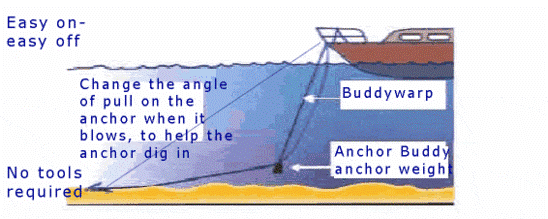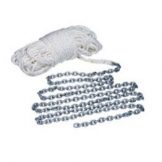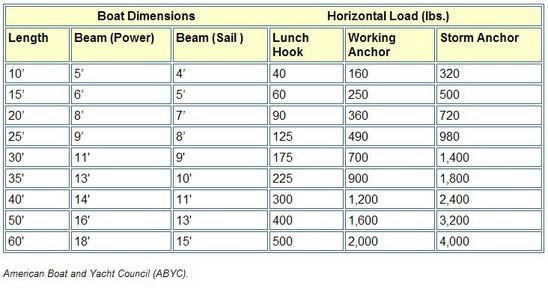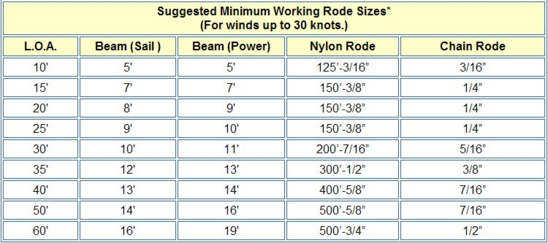Anchor Ground Tackle looks at the Equipment that attaches your boat to the anchor.
Ground tackle refers to all the parts of an anchor package between the boat and the anchor. If you use only line the ground tackle may be referred to as simply the anchor rhode or line.
Anchor Scope and Catenary are important terms in anchoring.

Scope is the ratio of anchor line to the water depth. For example it its 10 feet deep and you pay out 30 feet of line or chain you have a scope of 3 to 1.
Catenary is a word which describes the curve of the ground tackle. In the diagram above you can see the curve which is exaggerated by the kellet from the horizontal line between anchor and boat.
For the anchor to hold best the pull on the anchor should be close to horizontal. The picture above shows how an anchor kellet helps keep the pull close to horizontal. The larger the scope the better the chance the pull will be horizontal.
Parts of ground tackle
- Chain; Chain is use for chafe protection and its weight keeps the pull on the anchor horizontal.
- Anchor Rhode; Nylon is best for a Rhode because of stretch characteristics
- Chain Rope Splice; below you will find Splice instructions.
- Shackles; Shackles need to be oversized and secured with wire or wire ties.
- Swivel; Swivels used between the Anchor and chain to let the anchor settle
- Snubbers; Snubbers dampening the jerkiness of riding at anchor
- Anchor kellet; This device is a weight that slides down the anchor line which helps lower the pull to horizontal as seen in the above diagram.
You do not need all these parts, you may just have some line and tie it to the Anchor. However the best systems will have many of these parts for best holding.
All Chain Ground Tackle

All chain is popular on large boats, heavy displacement boats, large power boats and Mega Yachts. The two benefits of chain are weight and chafe. Weight keeps the chain on the seabed which keeps the pull on the anchor close to horizontal.
The down side to all chain is again weight, and also the lack of stretch. Chain is heavy and 100 feet of 3/8 inch chain (10mm) will weight 136 lbs. Stowing this up forward in a boat vastly increases the chance of pitching in waves.
The second issue with all chain is lack of stretch. This manifest itself in 2 ways. First in a swell and high wind the boat is sailing around the anchor. As the boat gets further away, the ground tackle will load up and pull the boat back. This loading will transfer to the boat and the crew will feel the jarring. Just standing can be an issue because of this shock loading. Here it is necessary to have an anchor snubber to dampen the load.
The second result from lack of stretch with all chain is again anchoring in a swell. Here the load from the vessel is transferred through the chain and the forces transferred to the anchor, possibly braking it free. Again using a snubber will dampen the load.
TYPES OF ANCHOR CHAIN
Proof coil chain is made of low-carbon steel. It usually will have “G3” cast into each link. Its name comes from subjecting the chain to tensile loads (its proof load) until it breaks.. Anchor chains working load rating is usually 50 percent of the proof load. Proof coil is usually the least expensive chain, since it has fewer links per foot. Proof coil will not work with a windlass.
BBB chain (known as triple-B) is also a Grade-30 low-carbon steel. It can be identified by the “3B” cast into each link. It has been the chain of choice for boaters for years since its added weight creates more of a catenary and its shorter links have less chance to deform.
High Test (HT) chain is made from high-carbon steel that has been heat-treated to increase its strength. The heat treating gives HT chain a higher strength-to-weight ratio than other chain. “G43” or “G4” are cast into the links. With slightly longer links than BBB chain, many windlass manufacturers specify HT chain as the most compatible with their winches.
ANCHOR CHAIN COATINGS
Most anchor chains are galvanized. Some anchor chain can be purchased with a thin polymer coating. Vinyl coatings are also used, which makes the chain thicker, but gives more protection.
Stainless-steel anchor chain is also available. This is 316 stainless and is stronger than the steel, galvanized counterparts, but not as strong as high-carbon HT galvanized chain. It is also considerably more expensive than any of the galvanized chains. It does, however, prevent rust stains.
All rode Ground Tackle

For smaller boats having an all rope, anchor line, warp or rode is more popular. It is lighter, can be thrown, takes up less space and stretches. The down side is chafe.
Unlike chain rope stretches and this results in a smoother ride at anchor. When the boat swings at anchor and loads up the line, the load is dissipated by the stretch in the line. Unlike with Chain the load is not transferred to the anchor, and so the anchor is not effected.
RODE LINE TYPES
Twisted three-strand nylon rode, has good stretch properties, it also sinks. For the rode a nylon line is very strong and with the 3 strand construction has lots of stretch.
Polypropylene has good stretch floats but has poor shelf life in the sun.
Three-strand line can absorb shock and the constant tugging associated with anchoring much better than braided line.
Nylon Three-Strand line is the leading choice for use as an anchoring line. Lines generally come in a “soft” or “medium” lie. Soft lines are generally softer and loosely woven, than medium or hard lines for anchoring, as they are more prone to unraveling and chafing. Medium and hard lines are best to handle chafe. Lines that have been treated with a wax-like coating are available, and can help the line resist water/salt absorption.
Chain Rode combinations

Since all chain or all rode have their pros and cons a combination chain and rode is most popular. Here the chains weight and chafe characteristics prove their worth on the seabed. The rode proves its the stretch, so dampening any shock loads from the boat swinging around. Also the rode takes up less space.
So how much chain should we use? In the next section we look at how much anchor rode ground tackle you will need. This is calculated on scope. Scope is the ratio of water depth to line put out. This ratio is between 3:1 and in extreme cases 10:1.
Weighted Anchor Rode
If you need an anchor line but do not want to add chain you can opt for a weighted anchor line. Weighted line has some of the benefits of chain, but with being nicer to handle. The idea of a weighted line is that the whole line sinks and holds a strong catenary curve. This would be similar to how a chain falls. The curve helps damping and provides better anchor holding.
Weighted anchor line; FSE Robline is one manufacturer
The benefit of a weighted line is you can have the benefits of chain, but without the harsh handling. You can lead the line over a gunwale or side deck without damaging the surface. Also good for RIBs and Inflatables. The line is also much quieter than chain, plus it does not leave rust stains.
Chain to Rode length calculation
Some rules of thumb say one ft of chain per foot of boat length. Another says one lb of chain for every pound of anchor. Earl Hinz, a former aeronautical engineer and inveterate Pacific Ocean sailor, in his work says the chain should weigh at least as much as the anchor whose weight it is supplementing.
From his experience, he has determined that the length of the chain lead has nothing to do with the depth of the water or the length of the boat. He suggests using the following formula to help you determine the minimum length of chain lead you will need:
Length of chain = (Anchor weight in lbs x Anchor materials factor ) divided by weight of chain lbs./ft. Anchor materials factor = 1 for steel and 1.6 for aluminum
For example: If you have a 7-lb. Fortress aluminum anchor with a 1/2 inch twisted three-strand nylon rode, you would need to use at least 11.2 lbs of 5/16 inch proof coil chain, which weighs 1.15 lbs per foot. Therefore, you will need at least 9 ft 8 inches of boat anchor chain.
Reference; Earl Hinz, The Complete Book of Anchoring and Mooring
Size of the anchor ground tackle

How do I know what chain diameter I need and what line size do I need. These diagrams from ABYC will help you decide.
This Chart above, gives you an anchor horizontal loads at various wind speeds. For a 30 ft boat the horizontal load is 700 lbs for a Working Anchor which is rated at 30 knots. Below you will se that for this boat 7/16 inch line is recommended and 5/16 inch chain.
From these loads we can build this chart from ABYC to give us the required chain and rode sizes.

